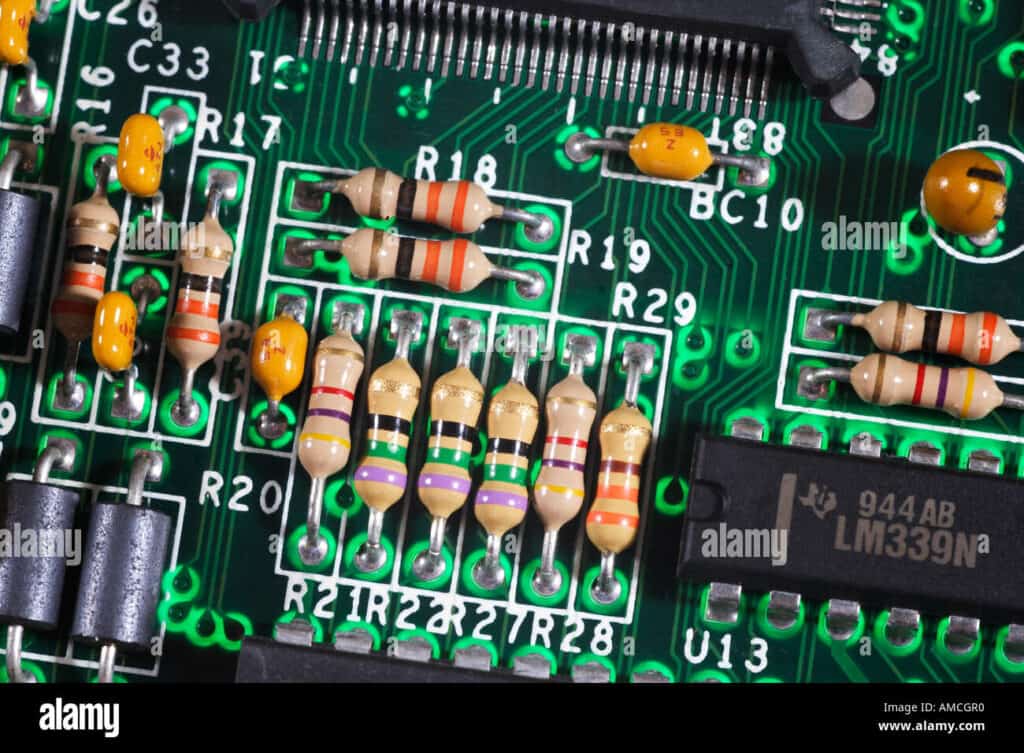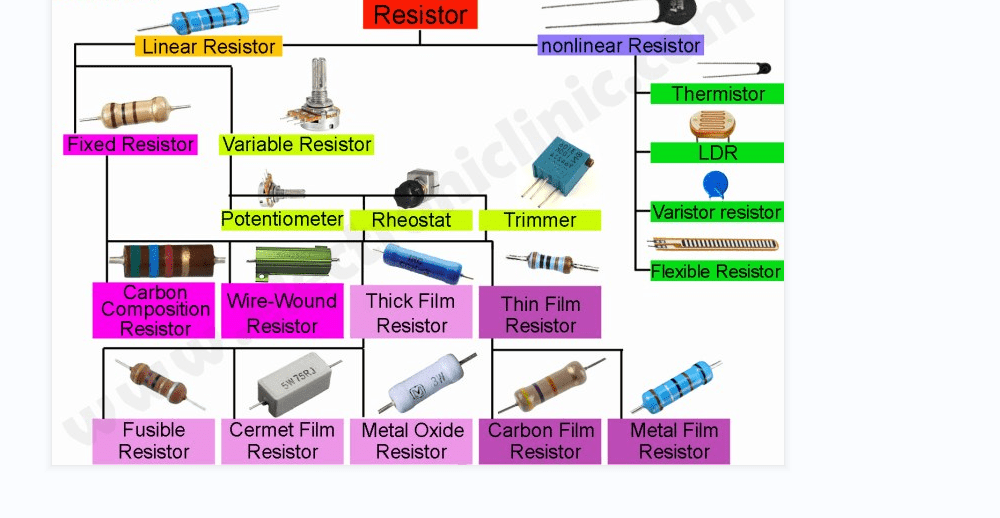Resistors are one of the most fundamental components of electronic circuits. They are used to limit the flow of current and to provide a specific resistance value to a circuit. Resistors come in a variety of shapes, sizes, and materials, and their design is critical to the performance of electronic devices.
The design of resistors involves a number of factors, including the material used, the physical size and shape of the resistor, and the desired resistance value. The most common materials used in resistor construction are carbon, metal film, and wirewound. Each material has its own advantages and disadvantages, and the choice of material depends on the specific application and performance requirements. The physical size and shape of the resistor can also affect its performance, as larger resistors tend to have lower noise and better thermal stability. Finally, the desired resistance value is determined by the application and can range from a few ohms to several megaohms.

Overview of Resistors
Resistors are passive electronic components that are used to control the flow of current in a circuit by providing resistance. They are widely used in various electronic circuits, ranging from simple LED circuits to complex microcontrollers. The basic function of a resistor is to resist the flow of electrical current, which is measured in ohms (Ω).
Types of Resistors
There are various types of resistors available in the market, each with its unique properties and applications. Some of the commonly used types of resistors are:
-
Carbon Composition Resistors: These resistors are made of carbon and a binder material, which is molded into a cylindrical shape and coated with an insulating material. They are low-cost and have a high tolerance for temperature changes.
-
Metal Film Resistors: These resistors are made of a thin film of metal, which is deposited on a ceramic substrate. They have a high accuracy and stability, making them suitable for use in precision circuits.
-
Wirewound Resistors: These resistors are made of a wire that is wound around a ceramic or metal core. They have a high power rating and are suitable for use in high-current applications.
-
Surface Mount Resistors: These resistors are designed to be mounted directly on the surface of a printed circuit board (PCB). They are small in size and are commonly used in compact electronic devices.
Properties of Resistors
The properties of resistors vary depending on the type of resistor and its application. Some of the key properties of resistors include:
-
Resistance: This is the most important property of a resistor, which is measured in ohms (Ω). The resistance of a resistor determines the amount of current that can pass through it.
-
Tolerance: This is the amount by which the actual resistance of a resistor can vary from its nominal value. The tolerance is expressed as a percentage of the nominal value.
-
Power Rating: This is the maximum amount of power that a resistor can dissipate without getting damaged. The power rating is expressed in watts (W).
-
Temperature Coefficient: This is the rate at which the resistance of a resistor changes with temperature. The temperature coefficient is expressed in parts per million per degree Celsius (ppm/°C).
In conclusion, resistors are essential components in electronic circuits, and their properties and types should be carefully considered when selecting the appropriate resistor for a particular application.
Design Considerations

Material Selection
The choice of material for a resistor is crucial in determining its performance and reliability. Resistors can be made from a variety of materials, including carbon, metal film, and wirewound. Carbon resistors are inexpensive and widely used but are less precise than metal film resistors. Metal film resistors offer greater precision and stability but are more expensive. Wirewound resistors are used for high-power applications and have excellent stability but are less precise than metal film resistors.
Size and Shape
The size and shape of a resistor can affect its performance and reliability. The size of a resistor is determined by its power rating, with larger resistors having higher power ratings. The shape of a resistor can affect its resistance value and temperature coefficient. For example, a cylindrical resistor has a lower temperature coefficient than a flat resistor, making it more stable over a wide range of temperatures.
Power Rating
The power rating of a resistor is the maximum amount of power that it can safely dissipate without overheating or failing. The power rating is determined by the physical size and construction of the resistor. Higher power ratings require larger resistors with thicker conductive elements. It is important to choose a resistor with a power rating that exceeds the maximum power that will be dissipated in the circuit.
In summary, when designing resistors, it is important to consider the material selection, size and shape, and power rating. The choice of material will affect the precision and stability of the resistor, while the size and shape will affect its resistance value and temperature coefficient. The power rating should be chosen to exceed the maximum power dissipated in the circuit.
Manufacturing Process
Film Resistors
The manufacturing process of film resistors involves depositing a thin film of resistive material onto an insulating substrate. The resistive material used is typically made of metal oxides or carbon. The film is then trimmed to the desired resistance value using laser trimming. The trimming process ensures that the resistor has a precise resistance value. Film resistors are known for their high accuracy, stability, and low noise.
Wirewound Resistors
Wirewound resistors are made by winding a resistive wire around a ceramic or fiberglass core. The wire used is typically made of nickel-chromium or copper-nickel alloy. The wire is wound tightly around the core to ensure a high resistance value. The wire is then coated with an insulating material to protect it from damage. Wirewound resistors are known for their high power handling capacity and low inductance.
Carbon Composition Resistors
Carbon composition resistors are made by mixing carbon powder with a binder material and molding the mixture into a cylindrical shape. The resistive element is then coated with a layer of carbon to improve its stability and reduce noise. The resistor is then trimmed to the desired resistance value using a mechanical grinder. Carbon composition resistors are known for their high stability and low noise.
In conclusion, the manufacturing process of resistors varies depending on the type of resistor being produced. Film resistors are made by depositing a thin film of resistive material onto an insulating substrate, wirewound resistors are made by winding a resistive wire around a ceramic or fiberglass core, and carbon composition resistors are made by mixing carbon powder with a binder material and molding the mixture into a cylindrical shape. Each type of resistor has its own unique characteristics and is suitable for different applications.
Testing and Quality Control
Performance Testing
To ensure the resistors meet the required specifications, performance testing is carried out. This involves measuring the resistance, tolerance, and temperature coefficient of resistance (TCR). The testing is done at various temperatures, frequencies, and voltages to ensure that the resistors can operate within the specified range.
Environmental Testing
Resistors are exposed to various environmental conditions during their lifetime. To ensure that the resistors can withstand these conditions, environmental testing is carried out. The testing includes exposure to temperature extremes, humidity, shock, and vibration. The resistors are also tested for their ability to withstand soldering and cleaning processes.
Quality Standards
The quality of resistors is critical to their performance and reliability. To ensure that the resistors meet the required quality standards, various tests are carried out. The resistors are tested for their conformity to industry standards such as MIL-PRF-55342, MIL-PRF-39009, and MIL-PRF-83401. The tests include visual inspection, dimensional inspection, and electrical testing.
| Test | Criteria |
|---|---|
| Visual Inspection | No visible defects |
| Dimensional Inspection | Conforms to specifications |
| Electrical Testing | Meets resistance, tolerance, and TCR specifications |
In addition to industry standards, the resistors may also be tested for compliance with customer-specific requirements. This ensures that the resistors meet the specific needs of the customer.
Overall, testing and quality control are critical to the design of resistors. By ensuring that the resistors meet the required specifications and quality standards, their performance and reliability can be guaranteed.
Applications

Circuit Design
Resistors are an essential component in circuit design, where they are used to limit current, adjust signal levels, and set the time constants of circuits. They are used in a wide range of electronic devices, including computers, smartphones, and televisions. In circuit design, resistors are often combined with other components, such as capacitors and inductors, to create filters, oscillators, and amplifiers.
Industrial Applications
Resistors are widely used in industrial applications, where they are used in control systems, power supplies, and motor control circuits. They are also used in heating elements, where they are used to convert electrical energy into heat. In industrial applications, resistors must be able to withstand high temperatures, vibrations, and other harsh conditions. Specialized resistors, such as wirewound resistors and ceramic resistors, are often used in industrial applications.
Consumer Electronics
Resistors are used in a wide range of consumer electronics, including televisions, radios, and home appliances. They are used to limit current, adjust signal levels, and set the time constants of circuits. In consumer electronics, resistors are often combined with other components, such as capacitors and inductors, to create filters, oscillators, and amplifiers. Surface mount resistors, which are small and easy to install, are often used in consumer electronics.
That’s it.

